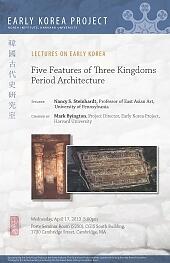Date:
Location:
Early Korea Project Lecture

Nancy S. Steinhardt
Professor of East Asian Art, University of Pennsylvania
Nancy S. Steinhardt is Professor of East Asian Art and Curator of Chinese Art at the University of Pennsylvania where she has taught since 1982. She received her Ph.D. at Harvard in 1981 where she was a Junior Fellow from 1978-81. Steinhardt taught at Bryn Mawr from 1981-1982. She has broad research interests in the art and architecture of China and China’s border regions, particularly problems that result from the interaction between Chinese art and that of peoples to the North, Northeast, and Northwest.
Steinhardt is author or co-author of Chinese Traditional Architecture (1984), Chinese Imperial City Planning (1990), Liao Architecture (1997), Chinese Architecture (2003), Reader in Traditional Chinese Culture (2005), Chinese Architecture and the Beaux-Arts (2011), Chinese Architecture in an Age of Turmoil, 300-600 (in press), and more than 70 scholarly articles. Steinhardt is currently writing a book on mosques in China. She is a recipient of grants from the Guggenheim Foundation, Institute for Advanced Study, National Endowment for the Humanities, American Council of Learned Societies, Getty Foundation, Chiang Ching-kuo Foundation, Social Science Research Council, American Philosophical Society, Graham Foundation for Advanced Study in the Fine Arts, and Metropolitan Center for Far Eastern Art. She has given more than 250 public lectures or conference talks. Steinhardt is currently involved in international collaborations in China, Korea, and Japan. Steinhardt has been an advisor, guest curator, or author for exhibitions at China Institute, Asia Society, the Metropolitan Museum, Japan Society, Chicago Art Institute, Smart Museum, and of course the Penn Museum.
Chaired by Mark Byington, Project Director, Early Korea Project, Harvard University
Abstract
This talk explores four structures or structural types that dominate Korean architecture in the fifth and sixth centuries: the octagonal building in Koguryŏ and Silla, octagonal ceilings in Koguryo tombs, twin structures in Koguryŏ and Silla, and the arrangement of brick layers in tombs. Relying on the most recent archaeological evidence, the talk investigates the geographic extent of each form in one of the Korean kingdoms, across kingdoms, and in China and Japan. The conclusion will address the legacy of Three Kingdoms period architecture in Northeast Asia in the eleventh century.
Sponsored by the Early Korea Project at the Korea Institute. The Early Korea Project receives operational funding from the Korea Foundation.
Funding for this lecture series is provided by the Northeast Asian History Foundation, Seoul.